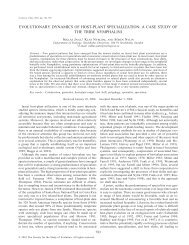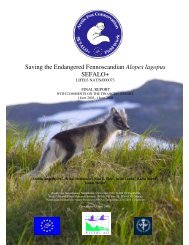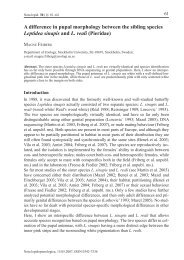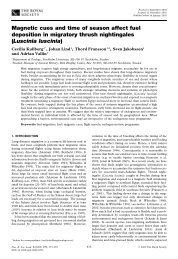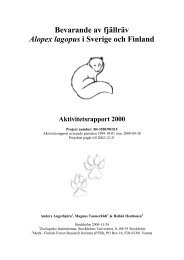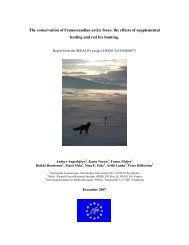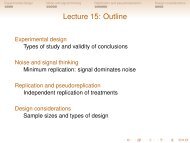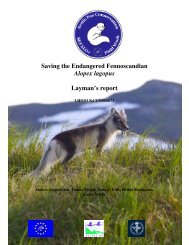Evolution of Fighting Behaviour: The Effect of Variation in Resource ...
Evolution of Fighting Behaviour: The Effect of Variation in Resource ...
Evolution of Fighting Behaviour: The Effect of Variation in Resource ...
Create successful ePaper yourself
Turn your PDF publications into a flip-book with our unique Google optimized e-Paper software.
and thus for an ESSGAMES WITH VARIATION IN RESOURCE VALUEp(st) >-p(s2)C(s,) >- C(s2)p(sl)>p(s2)if and only if C(st)> C(s2).203(B3)(B4)(BS)From (B2) one obta<strong>in</strong>s that U( V~, s~) -> U( Vl, s2) and U( V2, sl) -p(sz)[Vt-V2].S<strong>in</strong>ce Vt - V2 is positive, (B3) follows. Us<strong>in</strong>g aga<strong>in</strong> that U( V2, s~) < U( t/2, s2), oneobta<strong>in</strong>s with (B1)C(st) - C(s2) -> [p(st) - p(s2)] V2,which together with (B3) yields (B4). This <strong>in</strong>equality also gives the "only if" part<strong>of</strong> (B5), and the "if" part follows similarly from U(Vt, st) -> U( VI, s2). F<strong>in</strong>ally, ifp(st)=p(s2) and c(sl)=c(s2) then, although s~ might differ from s2, from aneconomic po<strong>in</strong>t <strong>of</strong> view they are identical <strong>in</strong> this contest situation, and noth<strong>in</strong>g morecan be said.APPENDIX CA brief description <strong>of</strong> the procedure used to determ<strong>in</strong>e ESS's for the sequentialassessment games studied <strong>in</strong> this paper will be given. This procedure is very similarto the one used <strong>in</strong> Enquist & Leimar (1983) and Leimar & Enquist (1984), and thereader is referred to these papers for further details.<strong>The</strong> relative fight<strong>in</strong>g ability between <strong>in</strong>dividual A and <strong>in</strong>dividual B is regardedas a stochastic variable, denoted O, with probability density ft. At step i, A observesyA=o+Z~, and B observes Yff=-O+Zff, where Z~ A and Zff (the errors <strong>of</strong>observation) are <strong>in</strong>dependent and normal with mean zero and standard deviation~r. <strong>The</strong> two players' successive estimates <strong>of</strong> their relative fight<strong>in</strong>g ability are representedas two stochastic processes, X 2 and Xff, where X~ is the average <strong>of</strong> the n firsty/A and similarly for Xff.An <strong>in</strong>dividual's strategy is given by a collection <strong>of</strong> switch<strong>in</strong>g l<strong>in</strong>es (local strategies),one for each subjective resource value (only discrete distributions <strong>of</strong> subjectiveresource value will be considered). Denote B's switch<strong>in</strong>g l<strong>in</strong>es by S" (m = 1,..., M),and let a,, be the prior probability that B uses Sm. We wish to compute the bestreply for A to B's strategy. This will be done by comput<strong>in</strong>g A's best switch<strong>in</strong>g l<strong>in</strong>eseparately for each <strong>in</strong>itial subjective resource value for A. Let 17" denote a particular<strong>in</strong>itial subjective resource value for A and let S' be the correspond<strong>in</strong>g best localstrategy for A. <strong>The</strong> choice <strong>of</strong> local strategy by B might conta<strong>in</strong> <strong>in</strong>formation aboutthe resource for A, and one can regard A's subjective resource value as a stochasticvariable, V, which takes the value Vm when B uses S". A's <strong>in</strong>itial subjective resourcevalue then becomes 17 = y~,. V,,a,,.



